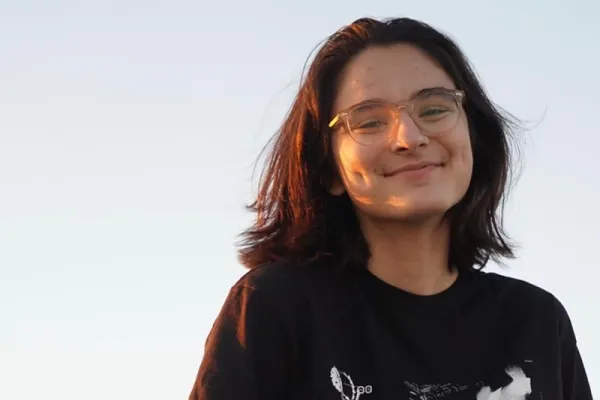Maggie Olszewski ’23: Life, Loneliness and Laika
Research & Inquiry

Published December 8, 2021
Many 17-year-olds turn to writing to make sense of the countless emotions, concerns and confusions so characteristic of that age, but few ever have their innermost thoughts published by a prestigious international press. Maggie Olszewski ’23 is the exception.
An English literature and film double major at Smith, Olszewski recently had her first chapbook, titled “Laika,” published by Black Sunflowers Poetry Press, the United Kingdom’s first crowdfunded poetry press that features the work of women and Black poets.
The book began to take shape when Olszewski attended the South Carolina Governor’s School for the Arts and Humanities, a public residential arts high school in Greenville, South Carolina. It was her attempt at 17 (she will soon turn 21) to come to terms with the feelings of loneliness, isolation and anxiety she was experiencing about the future. Olszewski’s inspiration for the poems came from the story of Laika—a Siberian husky stray who was one of the first dogs shot into space as part of the Soviet space program in the mid-1950s, never to return. “The loneliness aspect definitely felt like a thread between us,” Olszewski says. According to the publisher’s Facebook page, “Laika” is, to date, its fastest selling chapbook ever.
Olszewski’s skill as a writer has been acknowledged before. In high school, she was named a Top 15 Foyle Young Poet of the Year (the premier competition for young poets between the ages of 11 and 17) for her poem “At a Funeral.” And in 2019, Olszewski received a national gold medal from Scholastic Art and Writing Awards for an essay titled “Gap,” about growing up without a mother and the roles her father and the women in her family played in her life.
Here Olszewski, who has interned at The Boutelle-Day Poetry Center and is doing a poetry concentration at Smith, talks more about “Laika,” how she learned to love poetry, and why it’s so meaningful to her.
THERE ARE AROUND 20 POEMS. I wrote them when I was 17 and I’m turning 21 next month, so a lot has changed. When I read the book now, I recognize a lot of things that I don’t feel anymore, but I did feel very strongly then. I was a 17-year-old coping and asking questions of the world. I was learning about my own queer identity. I was away at a boarding school, so I was dealing with a lot of mental health issues on my own. I felt isolated a lot of the time, and I think that comes through. A lot of the poems talk about loneliness and feeling stranded. I think a lot of the poems are about me trying to make sense of myself as I stood in the world and what I thought of love and what I thought of the people around me and what I thought of the future.
IN SCHOOL, I READ “EDITH,” A CHAPBOOK BY MEG FREITAG, which is a beautiful series of poems addressed to her dead bird, Edith. I remember reading that and sobbing because the idea of writing these poems about or to this dead animal—even if the animal was alive—she wouldn’t be able to really talk to you anyway. The inherent loneliness of that really got me. I was in this chapbook class, thinking about what I wanted to do, trying to find an idea that I would care about and that would keep me interested enough to complete the book. I had known about Laika for a very long time. In thinking about ideas, I thought of Edith and kept coming back to Laika. No one is unmoved by Laika’s story—it felt very personal in a weird way.
IT WOULD BE NICE IF A POEM RESONATED WITH SOMEONE. That would mean a lot to my 17-year-old self, knowing that my angst wasn’t lost to the depths of my Google drive. A lot of the poems do deal with things that are general enough that I feel like a lot of people have similar experiences, like loneliness or wanting to know more about the world. I just want people to see themselves in it. Plus, a lot of people know about Laika, but a lot of people don't as well.
MATT DONOVAN [DIRECTOR OF THE BOUTELLE-DAY POETRY CENTER] IS SUCH A GOOD TEACHER. He is bringing new ideas to the table and getting people who aren’t into poetry engaged. Also, no one here has told me that my interpretation of a poem is wrong or silly. We don’t have multiple choice tests about poems. It’s a very positive way of teaching and learning about poetry. I think that a lot of people here at Smith are more open to poetry because of that. Reading poetry should be fun and engaging and interactive.
I SPENT SO LONG FINDING POETRY INACCESSIBLE. As soon as I realized that that was a farce and that was a thing that school made me think, I realized that it was the most accessible of all the art forms. Poems are meant to be broken down. If you write an essay, generally speaking, you must follow very specific rules, such as writing full sentences, most of the time. Whereas a poem can look like anything and still be a poem. In the world we live in right now—where everything is confusing and uncertain and all over the place—poetry can communicate these complexities and explore these big, unanswerable, universal questions.
Maggie Olszewski ’23 will read from “Laika” at The Boutelle-Day Poetry Center on Thursday, Feb. 17, 2022, at 5:30 p.m.
Photograph by Hollings Rankin